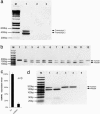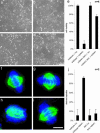RNA interference rescue by bacterial artificial chromosome transgenesis in mammalian tissue culture cells
- PMID: 15695330
- PMCID: PMC548992
- DOI: 10.1073/pnas.0409861102
RNA interference rescue by bacterial artificial chromosome transgenesis in mammalian tissue culture cells
Abstract
RNA interference (RNAi) is a widely used method for analysis of gene function in tissue culture cells. However, to date there has been no reliable method for testing the specificity of any particular RNAi experiment. The ideal experiment is to rescue the phenotype by expression of the target gene in a form refractory to RNAi. The transgene should be expressed at physiological levels and with its different splice variants. Here, we demonstrate that expression of murine bacterial artificial chromosomes in human cells provides a reliable method to create RNAi-resistant transgenes. This strategy should be applicable to all eukaryotes and should therefore be a standard technology for confirming the specificity of RNAi. We show that this technique can be extended to allow the creation of tagged transgenes, expressed at physiological levels, for the further study of gene function.
Figures




References
-
- Carpenter, A. E. & Sabatini, D. M. (2004) Nat. Rev. Genet. 5, 11-22. - PubMed
-
- Dykxhoorn, D. M., Novina, C. D. & Sharp, P. A. (2003) Nat. Rev. Mol. Cell Biol. 4, 457-467. - PubMed
-
- Jackson, A. L., Bartz, S. R., Schelter, J., Kobayashi, S. V., Burchard, J., Mao, M., Li, B., Cavet, G. & Linsley, P. S. (2003) Nat. Biotechnol. 21, 635-637. - PubMed
Publication types
MeSH terms
Substances
LinkOut - more resources
Full Text Sources
Other Literature Sources

